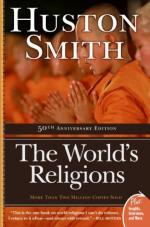|
This section contains 167 words (approx. 1 page at 400 words per page) |

|
Chapter VIII, Christianity, Eastern Orthodoxy, Summary and Analysis
A key feature of Eastern Orthodoxy is the autonomy of churches in various locations with varying degrees of intercommunication. In most areas, the Eastern Orthodox Church stands close to the Roman Catholic Church. The division came in 1054 A. D., mainly over what the Eastern Church saw as innovations to the creed. In contrast to the Roman Church, the Eastern Orthodox has no pope and believes that God's truth is revealed through the collective consciences of the churches. There is a kind of corporate mentality within the Eastern thought whereby individuals work out their salvation not simply individually but in connection to the rest of the church. The laity has a much larger say in the decisions of the Eastern church, and the church encourages the mystical life more than does the Roman church...
(read more from the Chapter VIII, Christianity, Eastern Orthodoxy, Summary)
|
This section contains 167 words (approx. 1 page at 400 words per page) |

|




